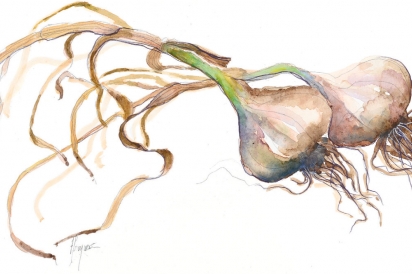Planting in Autumn, Dreaming of Spring
Hints for jump-starting your Idaho garden
There’s so much to love about autumn in Idaho: golden aspen and red maples in the mountain draws; sunny days whose cool temperatures make hikes delightful; apples ripening for pies and applesauce; earlier sunsets that invite fires in the fireplace. For gardeners, though, this season offers a mixed blessing. In my high-altitude garden in the mountains south of Pocatello, late September and early October bring cleaning up and battening down, a time of endings. Sooner or later the evening comes when every single tomato must be harvested in anticipation of the first hard frost. The next morning only limp dead plants remain to be cleared, a process that can be pretty depressing.
Over the past three decades, though, I’ve learned some tricks from old-timers that temper autumn’s sense of finality and invite dreams of spring into the stark vegetable garden. One of the best is overwintering: sowing hardy plants in the fall that will provide fresh greens in early spring. Garlic and spinach, in fact, grow better in Idaho if sown in autumn. Here’s how to grow them.
Planting Garlic in Autumn
Garlic is one of the most foolproof vegetables in all but the coldest parts of the state. A member of the Allium family (which includes onions), garlic cloves actually require a chilling period, just like daffodil or tulip bulbs. If you plant garlic in the fall, you’ll be rewarded in March or April by mild green garlic shoots that can be clipped for a welcome taste of spring, then full heads of garlic in the summer.
Fall planting for garlic should take place after the first hard frost, when the soil is cool but still workable. (Average dates are September 11–20 in Pocatello and Hailey, and Oct. 1–10 in Boise and Twin Falls, but follow the weather report.) Separate heads of planting garlic (see below) into cloves, leaving the papery covering on. Work the bed, adding compost, and plant each clove about two inches deep with the broad side down and the pointy side up. After they’re covered with soil, mulch with a layer of straw or fallen leaves about six inches deep. Then sit back and cultivate trust.
When days grow warmer and the mulch softens, remove it. You should see little green shoots poking through the ground (if you don’t, put a little mulch back). Once the shoots start to look like leaves, you can clip a few from each plant to use in cooking. Allow the garlic to grow through the early summer, watering it well. When the stalks turn yellow and bend over, it’s time to harvest (mid-July where I live). Dig up the heads, wash off the dirt and let them cure by spreading them in the shade on a picnic table or screen, with good air circulation. Then they’re ready to braid or store.
Remember that the garlic you harvest is only as good at the garlic you plant. And please note that using supermarket garlic as a start not only guarantees a bland harvest—it’s also illegal in Idaho. In fact, it’s illegal to plant any garlic bulbs/cloves that do not come from a source certified by the Idaho State Department of Agriculture as free of white rot. This dangerous fungal disease threatens the production of onions, shallots and leeks as well garlic; the quarantine is in place to protect those who make their living from agriculture. Look for heirloom varieties produced by a source that has been certified by ISDA, either hardneck varieties (these form a nodding “scape” of little bulbs at the top and make bigger cloves) or softneck varieties (these mature faster). Both grow well in my garden. Among my favorites are Music, Italian Purple, Silver Rose, Siberian and Chesnok Red. Look for a certified grower at your local farmers market or organic grocery.
Planting Spinach in the Autumn
Ever had your spinach bolt (go to seed and get bitter) frustratingly soon after it came up? This is a common problem in Idaho, because as days get longer spinach automatically moves into reproduction mode.
Planting spinach in the fall can help insure a longer harvest. Full disclosure: This tactic is more iffy than the previous one, and some years only dead spinach appears when the snow melts—but a package of seeds is cheap, right? And one of the most heartwarming things imaginable—an Easter-like reassurance of rebirth—is green spinach leaves that have survived the winter plumping in the March garden.
To overwinter spinach, sow it in the fall about six weeks before the first hard frost, and let the plants grow to about three to four inches. Once they reach this size or just before the first frost (whichever comes first), mulch them with 12 inches of straw and let them hibernate. When days get warmer (in late March or so), gradually uncover the spinach over a few days, a few inches at a time. Water, then harvest when the plants get big enough. Cold-hardy varieties like Giant Winter, Melody and Tyee work well.
Overwintering takes only a little effort, and it’s heartening to regard a snow-covered garden and know that something is very much alive out there. It’s nicer still to eat fresh greens from your property while your neighbors are just starting to think about their gardens.
Susan Swetnam is a professor emerita at Idaho State University. Her articles and creative nonfiction pieces have appeared in a variety of national, scholarly, regional and little magazines, including Gourmet, Mademoiselle, Frontiers: A Journal of Women’s Studies and Journal of the West; and in the Greenwood Press American Regional Cultures series, to which she contributed a chapter on foodways of the Northern Rockies. She lives and cooks in Pocatello.





